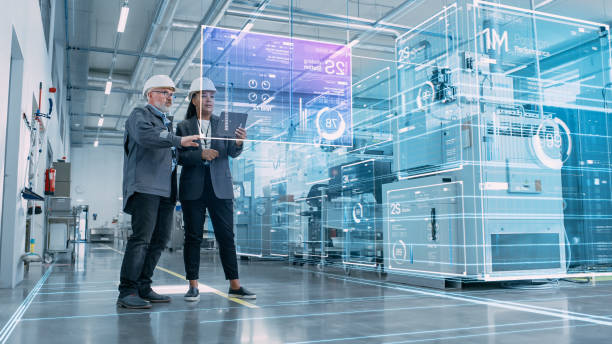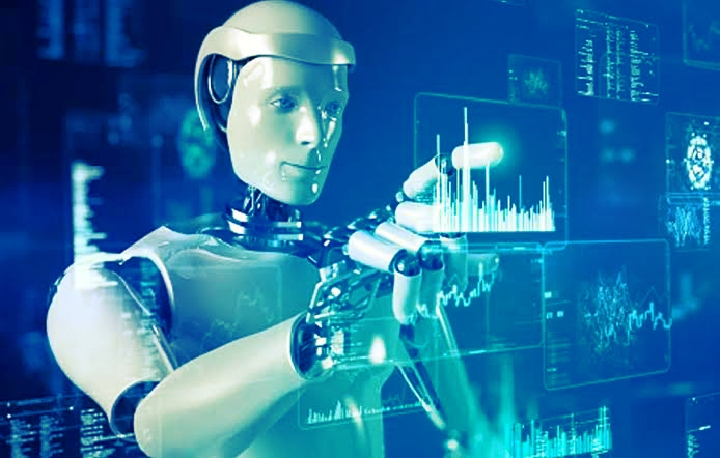Artificial Intelligence Many aspects of human existence could be altered by the revolutionary technology known as artificial intelligence (AI). It has unnatural effects on the entertainment, financial, transportation, healthcare, and other industries. It also has an effect on how we live, work, and interact with the world around us. It is not only necessary but also an academic endeavor to comprehend the profound counteraccusations of AI as we navigate the challenges of the digital age. There is a wide range of AI products that add in previously unimaginable ways to productivity, effectiveness, and decision-making processes. AI systems have demonstrated remarkable capabilities in data analysis, pattern recognition, and problem-solving through sophisticated algorithms and machine literacy methods. This has opened up new opportunities for prophetic analytics, substantiated drugs, and autonomous vehicles. AI-powered technologies have also normalized access to information and services, bridging social and economic divides and giving people of all backgrounds a voice. Nonetheless, AI’s profound ethical, societal, and empirical counteraccusations outweigh its transformative potential. Businesses involving sequestration, bias, and job relegation highlight the need for robust ethical materials and nonsupervisory safeguards to avoid implicit pitfalls and guarantee impartial issues. Also, as AI continues to develop at an unknown rate, the need to address control, transparency, and responsibility grows. AI’s future holds promise but also danger.From the development of intelligent machines to sentient systems, the direction that artificial intelligence (AI) is taking is still the subject of numerous debates. It is our duty as servants of this technological frontier to use AI’s power for humanity’s benefit and protect ourselves from its unintended consequences. We must do so with wisdom, foresight, and compassion. Understanding its impact and counteraccusations is crucial to responsible invention and collaborative progress in this journey toward an AI-facilitated future.

How Artificial Intelligence (AI) Works
Data, algorithms, and computing power are used to mimic human cognition and solve difficult problems. Unnaturally based on machine literacy algorithms, AI systems are able to dissect large amounts of data and find patterns that they then use to make predictions, opinions, and recommendations. supervised literacy, in which an algorithm is trained on labeled data to learn the relationship between inputs and labors, is one method of abecedarian AI. A supervised literacy algorithm, for instance, learns to recognize objects in image recognition tasks by analyzing labeled images and connecting them to relevant orders. On the other hand, unsupervised literacy teaches an algorithm to find old data structures and patterns by using unlabeled data. In tasks like clustering and dimensionality reduction, where the goal is to group data points that are similar or extract meaningful features, this method is frequently used. Another huge man-made knowledge perspective is support education, in which experts gain capability with the slick lead through preliminary collaborations with their ongoing situation and are redressed or repelled for their molding. Playing games and controlling robots are two examples of tasks that require successional decision-making, so this system is ideal. The use of neural networks with multiple layers of connected bumps to automatically prize hierarchical data representations has made deep literacy, a subset of machine literacy, a potent AI strategy. These deep neural networks perform admirably in a wide range of applications, including independent driving, natural language processing, and image and speech recognition. In practice, AI systems all go through the same stages of data collection, preprocessing, model training, evaluation, and deployment. The AI system’s performance is continuously monitored and improved throughout this procedure to improve its delicateness, effectiveness, and responsibility. AI generally revolutionizes diligence and drives innovation across a variety of fields by employing slice-edge algorithms and computational caches to learn from data and perform intelligent tasks that were previously thought to be exclusive to mortal cognition.

What Is Artificial Intelligence?
The merging of cognitive psychology, mathematics, and computer science with the aim of producing machines with intelligence comparable to that of humans is referred to as “artificial intelligence” (AI). It is the product of human imagining. Artificial intelligence (AI) is, at its core, a collection of methods and styles designed to give machines the ability to perceive, reason, learn, and act independently, constantly surpassing or imitating human cognitive abilities. Machine literacy, a subset of AI that enables systems to learn from data without explicitly programming, is one prominent example of AI in action. Machine literacy algorithms like neural networks and decision trees, which are suitable to celebrate intricate patterns, make predictions, and adapt to new information, make operations like recommendation systems, natural language processing, and image recognition possible. Natural language processing is used by virtual sidekicks like Apple’s Siri and Amazon’s Alexa to interpret and respond to stoner commands. This demonstrates that AI can instantly comprehend and instigate human language. Additionally, platforms like Netflix and Spotify use AI-driven recommendation machines to analyze stoner preferences and geste in order to curate substantiated happy recommendations, which improves stoner engagement and experience. The promise that AI-powered individual tools and prophetic analytics can modify complaint discovery and treatment in healthcare is another compelling illustration of AI’s transformative potential. Machine literacy algorithms are used by systems like IBM’s Watson Oncology to analyze a lot of medical literature and case data. Croakers can use this data to create individual treatment plans and diagnose problems. To ensure the safety of passengers, tone-driving automobiles use artificial intelligence (AI) to interpret sensitive inputs, navigate complex environments, and make split-alternative decisions. With AI-driven systems that are constantly learning and adapting to a variety of driving conditions, Tesla and Waymo are at the forefront of this technological frontier. This represents a paradigm shift toward transportation efficiency and autonomy.

The Complexity Of Machine Intelligence
The decades of research and development that led to the technology that is now known as artificial intelligence, or AI, are the product of this. It’s a sign that humans and machines can collaborate to boost their intelligence in a new era. At its core, AI is a collection of methods and styles that aim to impart cognitive capabilities to machines, such as literacy, logic, perception, and solving problems. The foundation of many of today’s AI operations is machine literacy, a subset of AI that enables systems to learn from data and improve over time without needing to be programmed. Neural networks, decision trees, and support vector machines give machines the ability to recognize intricate patterns, make predictions, and adapt to their surroundings. Deep literacy, a sophisticated form of neural network-based literacy, has also led to advancements in tasks like speech and image recognition as well as natural language processing, allowing AI to enter areas that were previously restricted to humans only. Underpinning literacy, another well-known AI strategy, paves the way for advancements in robotics, gaming, and autonomous systems by allowing agents to learn optimal actions through commerce with their surroundings. Among the many novel approaches that AI technology incorporates are emblematic logic, expert systems, and knowledge representation. Each of these strategies can be used in a specific situation and problem area. To imitate the decision-making processes of real experts, expert systems make use of rules and knowledge that are unique to each sphere. As a result, these systems can provide customized recommendations, resolve specific issues, and diagnose ailments. Knowledge representation styles in discrepancy make it easier for machines to render and manipulate intricate knowledge structures, making it easier to reason and infer in scheduling, planning, and the semantic web.

Also, AI-specific, more energy-efficient computing platforms are now possible because of advances in AI technology that are becoming less complete. The speed and scalability of AI algorithms have been revolutionized by plates recycling units (GPUs), field-programmable gate arrays (FPGAs), and operation-specific integrated circuits (ASICs) designed specifically for AI calculations. Preparing and end have been advanced quickly by significant degrees thus. In addition, inventors and businesses have been able to make even more extensive use of the transformative potential of AI technology thanks to the democratization of access to AI databases brought about by the development of pall computing and edge computing architectures. It is anticipated that AI will have a profound and far-reaching impact on diligence, agriculture, and human civilization as a whole as it continues to develop and spread throughout society. This suggests that intelligence will be free in the future.
Benefits and Drawbacks of Computerized reasoning
Man-made consciousness( simulated intelligence) enjoys countless benefits and impediments because of its double nature as an extraordinary power and a certain opponent. In a number of fields, AI has the potential to improve decision-making, productivity, and effectiveness. One of the main benefits of robotization is that AI-powered systems can quickly and directly complete repetitive tasks, freeing up human resources for more creative and strategic endeavors. Additionally, AI excels at data analysis and pattern recognition, making it possible for businesses to select useful data from vast datasets and form well-informed opinions. For instance, AI-driven individual tools can speed up complaint discovery and treatment planning in the healthcare industry, alleviating patient issues and lowering healthcare costs. In order to reduce downtime and increase productivity, prophetic conservation systems and AI-enabled robots optimize manufacturing procedures. AI-powered particular companions and recommendation systems also improve stoner gests in entertainment, e-commerce, and content consumption by adapting services to individual preferences and increasing client satisfaction and fidelity.

On the other hand, AI has a lot going for it, but it also has a lot of issues that need to be resolved precisely. The possibility of job relegation and profitable dislocation is one of the main drawbacks of AI and robotization. Some jobs may become obsolete or require workers to retrain in order to remain relevant due to these technologies. Ethical, security, and sequestration businesses also expand as AI systems collect and dissect a large quantity of particulardata throughout the day. However, if AI algorithms are not properly designed and regulated, they may inadvertently perpetuate or exacerbate social inequalities, posing issues of fairness and bias. In addition, businesses’ concerns about transparency and responsibility in crucial operations like autonomous vehicles and healthcare diagnostics are raised by the opaque nature of AI decision-making processes. Additionally, the possibility of AI systems achieving preternatural intelligence raises doubts about humanity’s actual control and stewardship of similarly powerful technologies. As a result, ongoing discussions and governance frameworks are required to guarantee that AI promotes public good while minimizing implicit harm. In order to fully realize the transformative potential of AI for the benefit of society, it is essential to strike a balance between invention and responsibility in the complex geography of AI’s advantages and disadvantages.
Smart Spaces The World of